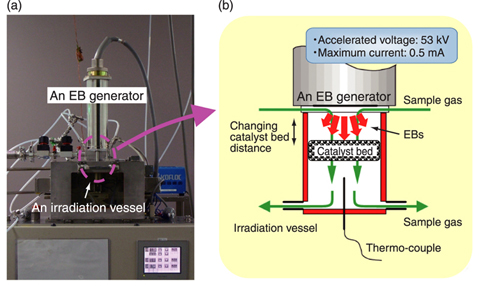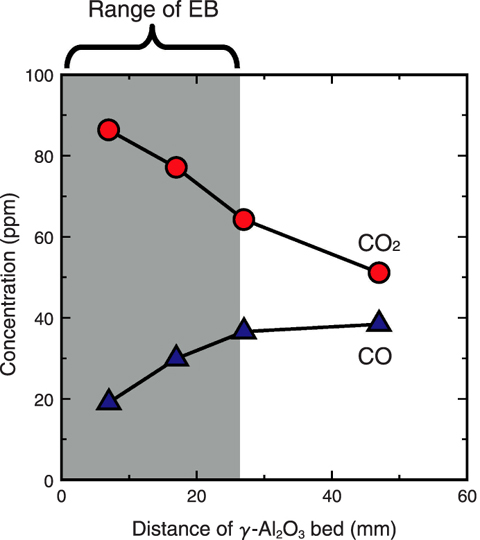
Fig.4-11 (a): An EB irradiation/catalyst system (external view), (b): an irradiation vessel for a gas stream (interior view)

Fig.4-12 The concentrations of CO2 and CO in 50-ppm xylene/air mixture irradiated at a dose of 10 kGy when γ-Al2O3 bed was placed at various distances
Emission of various organic substances from painting factories causes photochemical smog. We have developed a gas purification system that can oxidize organic substances into CO2 and CO using electron beam (EB) irradiation. In this treatment, such organic substances should be preferentially oxidized into CO2 without producing toxic CO. We have recently focused on the development of EB use with catalysts for this purpose and found that a γ-alumina (γ-Al2O3) bed exhibited the best catalytic activity together with an electron accelerator, especially when its surface is directly irradiated with EBs.
The EB irradiation involved a variety of chemical reactions. For the understanding of complicated radiation-induced catalytic reactions, we manufactured an EB irradiation/catalyst system that can irradiate a sample gas in the presence of a catalyst bed placed at various distances from an EB-irradiation window. (Fig.4-11) The catalytic oxidation of o-xylene in air was studied using a γ-Al2O3 bed as a catalyst. The results were summarized as follows;
(1) Higher CO2 concentration was obtained by an EB/ catalytic treatment.
(2) Irradiation products of xylene oxidized exclusively into CO2 over the γ-Al2O3 surface.
(3) The formation of CO2 was enhanced and the production of toxic CO was suppressed when a γ-Al2O3 bed was directly irradiated with EBs, namely placed in an EB-induced plasma. (Fig.4-12).
Our previous studies demonstrated that the placement of common catalysts such as TiO2 and MnO2 in an EB-irradiation space led to the decrease of CO2 concentration due to suppression of gas-phase oxidation reactions. On the other hand, the placement of γ-Al2O3 in the EB-irradiation space caused higher-concentration of CO2. Such catalytic oxidation activity was found to be due to the exclusive oxidation of the irradiation products of xylene over EB-irradiating γ-Al2O3 surface into CO2.
In general, metal oxides, such as γ-Al2O3, are made into chemical catalysts by loading noble metals on the surface. The present results are important not only for an EB-gas purification technology but also for production of a new catalyst which does not load any noble-metals.